浅谈中西方体育价值观 hl
- 格式:doc
- 大小:80.00 KB
- 文档页数:17
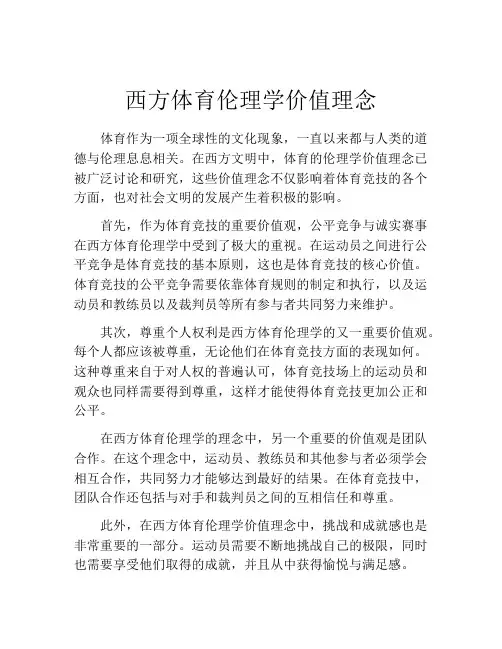
西方体育伦理学价值理念体育作为一项全球性的文化现象,一直以来都与人类的道德与伦理息息相关。
在西方文明中,体育的伦理学价值理念已被广泛讨论和研究,这些价值理念不仅影响着体育竞技的各个方面,也对社会文明的发展产生着积极的影响。
首先,作为体育竞技的重要价值观,公平竞争与诚实赛事在西方体育伦理学中受到了极大的重视。
在运动员之间进行公平竞争是体育竞技的基本原则,这也是体育竞技的核心价值。
体育竞技的公平竞争需要依靠体育规则的制定和执行,以及运动员和教练员以及裁判员等所有参与者共同努力来维护。
其次,尊重个人权利是西方体育伦理学的又一重要价值观。
每个人都应该被尊重,无论他们在体育竞技方面的表现如何。
这种尊重来自于对人权的普遍认可,体育竞技场上的运动员和观众也同样需要得到尊重,这样才能使得体育竞技更加公正和公平。
在西方体育伦理学的理念中,另一个重要的价值观是团队合作。
在这个理念中,运动员、教练员和其他参与者必须学会相互合作,共同努力才能够达到最好的结果。
在体育竞技中,团队合作还包括与对手和裁判员之间的互相信任和尊重。
此外,在西方体育伦理学价值理念中,挑战和成就感也是非常重要的一部分。
运动员需要不断地挑战自己的极限,同时也需要享受他们取得的成就,并且从中获得愉悦与满足感。
在对待失败的问题上,西方体育伦理学同样强调了宽容和尊重。
成功与失败在体育竞技中是很常见的两种情况,但不管是哪种情况,在比赛结束之后都应该对运动员保持尊重,同时在失败时向他们提供支持和安慰。
最后,西方体育伦理学还富有包容性和多样性的思想。
体育竞技对于任何一个人来说都是开放的,并且允许参与者来自当地和全球各地。
在西方体育伦理学的理念中,人们应该理解和尊重不同人群间的文化和个人差异。
总之,西方体育伦理学价值理念显示出了很高的文明和社会责任感,在今天与未来的体育竞技发展中都起着重要的指导作用。
这些价值理念不仅仅对体育有积极的影响,也可在我们日常生活中看到它们的体现。
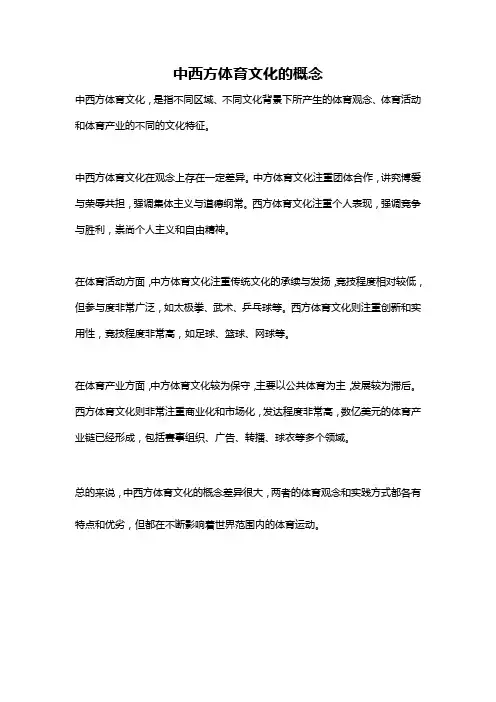
中西方体育文化的概念
中西方体育文化,是指不同区域、不同文化背景下所产生的体育观念、体育活动和体育产业的不同的文化特征。
中西方体育文化在观念上存在一定差异。
中方体育文化注重团体合作,讲究博爱与荣辱共担,强调集体主义与道德纲常。
西方体育文化注重个人表现,强调竞争与胜利,崇尚个人主义和自由精神。
在体育活动方面,中方体育文化注重传统文化的承续与发扬,竞技程度相对较低,但参与度非常广泛,如太极拳、武术、乒乓球等。
西方体育文化则注重创新和实用性,竞技程度非常高,如足球、篮球、网球等。
在体育产业方面,中方体育文化较为保守,主要以公共体育为主,发展较为滞后。
西方体育文化则非常注重商业化和市场化,发达程度非常高,数亿美元的体育产业链已经形成,包括赛事组织、广告、转播、球衣等多个领域。
总的来说,中西方体育文化的概念差异很大,两者的体育观念和实践方式都各有特点和优劣,但都在不断影响着世界范围内的体育运动。
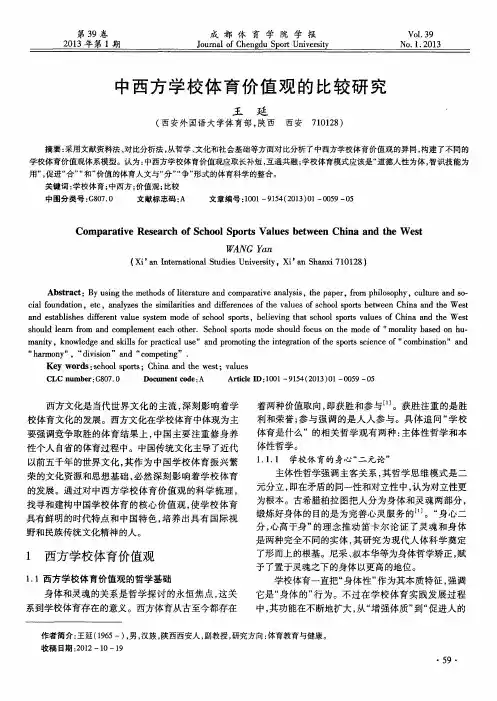
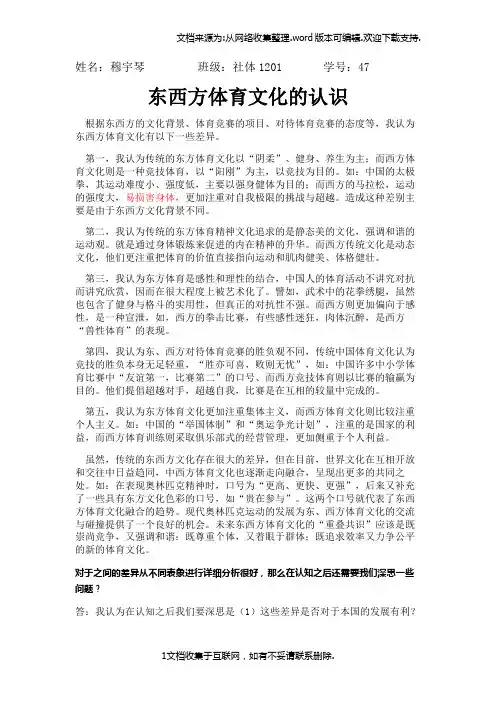
姓名:穆宇琴班级:社体1201 学号:47东西方体育文化的认识根据东西方的文化背景、体育竞赛的项目、对待体育竞赛的态度等,我认为东西方体育文化有以下一些差异。
第一,我认为传统的东方体育文化以“阴柔”、健身、养生为主;而西方体育文化则是一种竞技体育,以“阳刚”为主,以竞技为目的。
如:中国的太极拳,其运动难度小、强度低,主要以强身健体为目的;而西方的马拉松,运动的强度大,易损害身体,更加注重对自我极限的挑战与超越。
造成这种差别主要是由于东西方文化背景不同。
第二,我认为传统的东方体育精神文化追求的是静态美的文化,强调和谐的运动观。
就是通过身体锻炼来促进的内在精神的升华。
而西方传统文化是动态文化,他们更注重把体育的价值直接指向运动和肌肉健美、体格健壮。
第三,我认为东方体育是感性和理性的结合,中国人的体育活动不讲究对抗而讲究欣赏,因而在很大程度上被艺术化了。
譬如,武术中的花拳绣腿,虽然也包含了健身与格斗的实用性,但真正的对抗性不强。
而西方则更加偏向于感性,是一种宣泄,如,西方的拳击比赛,有些感性迷狂,肉体沉醉,是西方“兽性体育”的表现。
第四,我认为东、西方对待体育竞赛的胜负观不同,传统中国体育文化认为竞技的胜负本身无足轻重,“胜亦可喜,败则无忧”,如:中国许多中小学体育比赛中“友谊第一,比赛第二”的口号、而西方竞技体育则以比赛的输赢为目的。
他们提倡超越对手,超越自我,比赛是在互相的较量中完成的。
第五,我认为东方体育文化更加注重集体主义,而西方体育文化则比较注重个人主义。
如:中国的“举国体制”和“奥运争光计划”,注重的是国家的利益,而西方体育训练则采取俱乐部式的经营管理,更加侧重于个人利益。
虽然,传统的东西方文化存在很大的差异,但在目前,世界文化在互相开放和交往中日益趋同,中西方体育文化也逐渐走向融合,呈现出更多的共同之处。
如:在表现奥林匹克精神时,口号为“更高、更快、更强”,后来又补充了一些具有东方文化色彩的口号,如“贵在参与”。
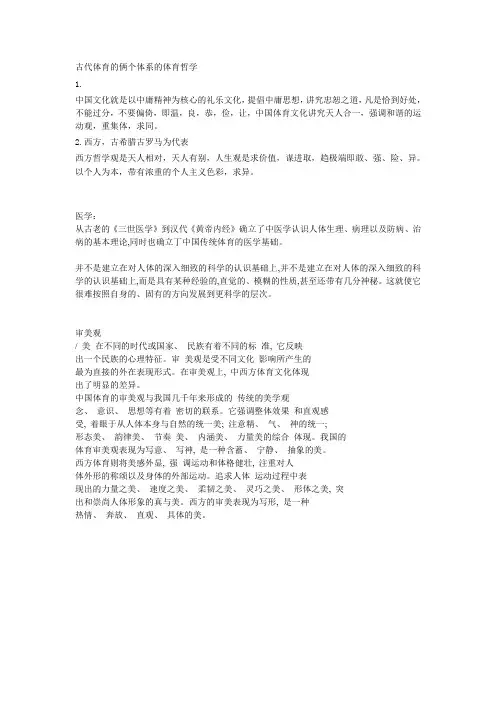
古代体育的俩个体系的体育哲学1.中国文化就是以中庸精神为核心的礼乐文化,提倡中庸思想,讲究忠恕之道,凡是恰到好处,不能过分,不要偏倚,即温,良,恭,俭,让,中国体育文化讲究天人合一,强调和谐的运动观,重集体,求同。
2.西方,古希腊古罗马为代表西方哲学观是天人相对,天人有别,人生观是求价值,谋进取,趋极端即敢、强、险、异。
以个人为本,带有浓重的个人主义色彩,求异。
医学:从古老的《三世医学》到汉代《黄帝内经》确立了中医学认识人体生理、病理以及防病、治病的基本理论,同时也确立丁中国传统体育的医学基础。
并不是建立在对人体的深入细致的科学的认识基础上,并不是建立在对人体的深入细致的科学的认识基础上,而是具有某种经验的,直觉的、模糊的性质,甚至还带有几分神秘。
这就使它很难按照自身的、固有的方向发展到更科学的层次。
审美观/ 美在不同的时代或国家、民族有着不同的标准, 它反映出一个民族的心理特征。
审美观是受不同文化影响所产生的最为直接的外在表现形式。
在审美观上, 中西方体育文化体现出了明显的差异。
中国体育的审美观与我国几千年来形成的传统的美学观念、意识、思想等有着密切的联系。
它强调整体效果和直观感受, 着眼于从人体本身与自然的统一美; 注意精、气、神的统一;形态美、韵律美、节奏美、内涵美、力量美的综合体现。
我国的体育审美观表现为写意、写神, 是一种含蓄、宁静、抽象的美。
西方体育则将美感外显, 强调运动和体格健壮, 注重对人体外形的称颂以及身体的外部运动。
追求人体运动过程中表现出的力量之美、速度之美、柔韧之美、灵巧之美、形体之美, 突出和崇尚人体形象的真与美。
西方的审美表现为写形, 是一种热情、奔放、直观、具体的美。
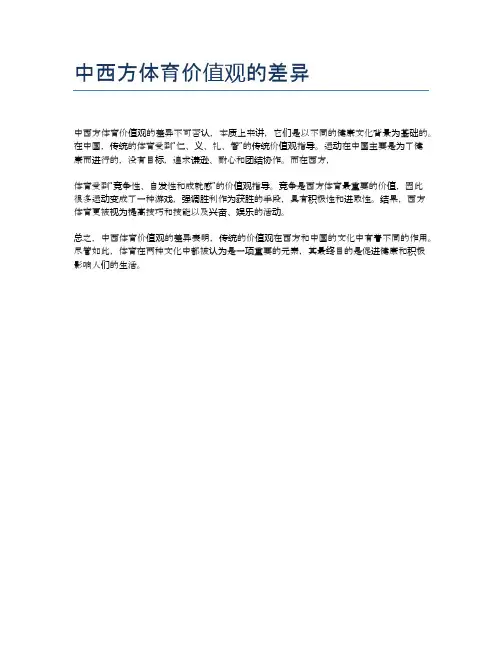
中西方体育价值观的差异
中西方体育价值观的差异不可否认,本质上来讲,它们是以不同的健康文化背景为基础的。
在中国,传统的体育受到“仁、义、礼、智”的传统价值观指导。
运动在中国主要是为了健
康而进行的,没有目标,追求谦逊、耐心和团结协作。
而在西方,
体育受到“竞争性、自发性和成就感”的价值观指导。
竞争是西方体育最重要的价值,因此
很多运动变成了一种游戏,强调胜利作为获胜的手段,具有积极性和进取性。
结果,西方
体育更被视为提高技巧和技能以及兴奋、娱乐的活动。
总之,中西体育价值观的差异表明,传统的价值观在西方和中国的文化中有着不同的作用。
尽管如此,体育在两种文化中都被认为是一项重要的元素,其最终目的是促进健康和积极
影响人们的生活。
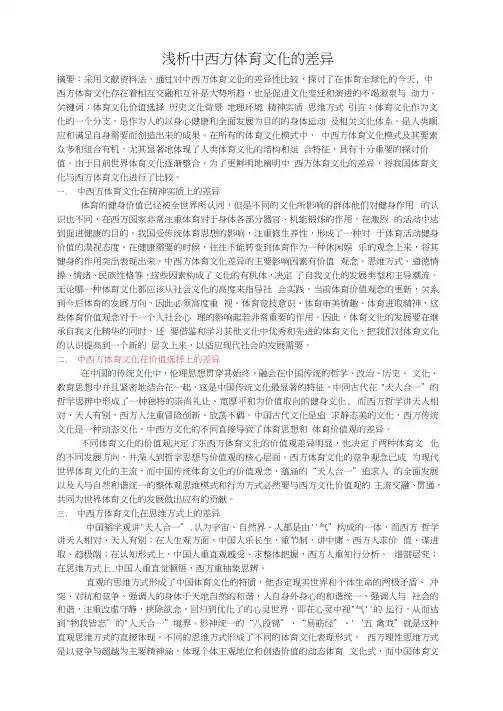
浅析中西方体育文化的差异摘要:采用文献资料法,通过对中西方体育文化的差异性比较,探讨了在体育全球化的今天, 中西方体育文化存在着相互交融和互补是大势所趋,也是促进文化变迁和演进的不竭源泉与动力。
关键词:体育文化价值选择历史文化背景地理环境精神实质思维方式引言:体育文化作为文化的一个分支,是作为人的以身心健康和全面发展为目的的身体运动及相关文化体系。
是人类顺应和满足自身需要而创造出来的成果。
在所有的体育文化模式中,中西方体育文化模式及其要素众多和组合有机,尤其显著地体现了人类体育文化的结构和组合特征,具有十分重要的探讨价值。
由于目前世界体育文化逐渐整合,为了更鲜明地阐明中西方体育文化的差异,将我国体育文化与西方体育文化进行了比较。
一.中西方体育文化在精神实质上的差异体育的健身价值已经被全世界所认同,但是不同的文化所影响的群体他们对健身作用的认识也不同,在西方国家非常注重体育对于身体各部分器官、机能锻炼的作用,在激烈的活动中达到促进健康的目的。
我国受传统体育思想的影响,注重修生养性,形成了一种对于体育活动健身价值的漠视态度。
在健康需要的时候,往往不能转变到体育作为一种休闲娱乐的观念上来,将其健身的作用突出表现出来。
中西方体育文化差异的主要影响因素有价值观念、思维方式、道徳情操、情绪、民族性格等,这些因素构成了文化的有机体,决定了自我文化的发展类型和主导潮流。
无论哪一种体育文化都应该从社会文化的高度来指导社会实践,当前体育价值观念的更新,关系到今后体育的发展方向,因此必须高度重视。
体育竞技意识、体育审美情趣、体育进取精神,这些体育价值观念对于一个人社会心理的影响起若非常重要的作用。
因此,体育文化的发展要在继承自我文化精华的同时,还要借鉴和学习其他文化中优秀和先进的体育文化,把我们对体育文化的认识提高到一个新的层次上来,以适应现代社会的发展需要。
二.中西方体育文化在价值选择上的差异在中国的传统文化中,伦理思想贯穿其始终,融会在中国传统的哲学、改治、历史、文化、教育思想中并且紧密地结合在一起,这是中国传统文化最显著的特征。
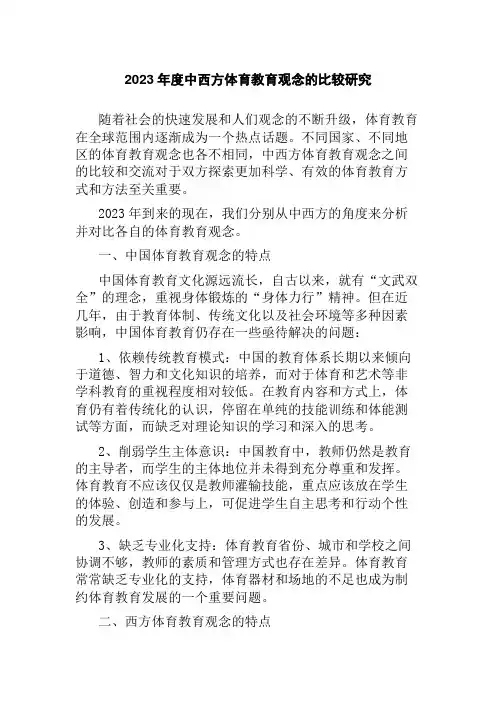
2023年度中西方体育教育观念的比较研究随着社会的快速发展和人们观念的不断升级,体育教育在全球范围内逐渐成为一个热点话题。
不同国家、不同地区的体育教育观念也各不相同,中西方体育教育观念之间的比较和交流对于双方探索更加科学、有效的体育教育方式和方法至关重要。
2023年到来的现在,我们分别从中西方的角度来分析并对比各自的体育教育观念。
一、中国体育教育观念的特点中国体育教育文化源远流长,自古以来,就有“文武双全”的理念,重视身体锻炼的“身体力行”精神。
但在近几年,由于教育体制、传统文化以及社会环境等多种因素影响,中国体育教育仍存在一些亟待解决的问题:1、依赖传统教育模式:中国的教育体系长期以来倾向于道德、智力和文化知识的培养,而对于体育和艺术等非学科教育的重视程度相对较低。
在教育内容和方式上,体育仍有着传统化的认识,停留在单纯的技能训练和体能测试等方面,而缺乏对理论知识的学习和深入的思考。
2、削弱学生主体意识:中国教育中,教师仍然是教育的主导者,而学生的主体地位并未得到充分尊重和发挥。
体育教育不应该仅仅是教师灌输技能,重点应该放在学生的体验、创造和参与上,可促进学生自主思考和行动个性的发展。
3、缺乏专业化支持:体育教育省份、城市和学校之间协调不够,教师的素质和管理方式也存在差异。
体育教育常常缺乏专业化的支持,体育器材和场地的不足也成为制约体育教育发展的一个重要问题。
二、西方体育教育观念的特点与中国的传统理念不同,西方体育教育注重科学化、专业化和个性化。
在一些发达国家中,体育教育已成为教育体系中不可分割的一部分,追求更多的开放性、多样性、有趣性和参与性。
1、注重科学化:西方体育教育注重科学的理论支撑和专业的训练方法,拓宽运动技能及知识,注重探讨体育科学的最新研究成果,以此指导学生的实际体能训练和技巧提高。
2、注重个性化:西方体育教育重覆盖面积、全面性和个性化。
在课程内容和教学方式上,学生的兴趣和特点被充分考虑,促进学生的北斗艺术特长、个性特点和创造力等方面的发展。
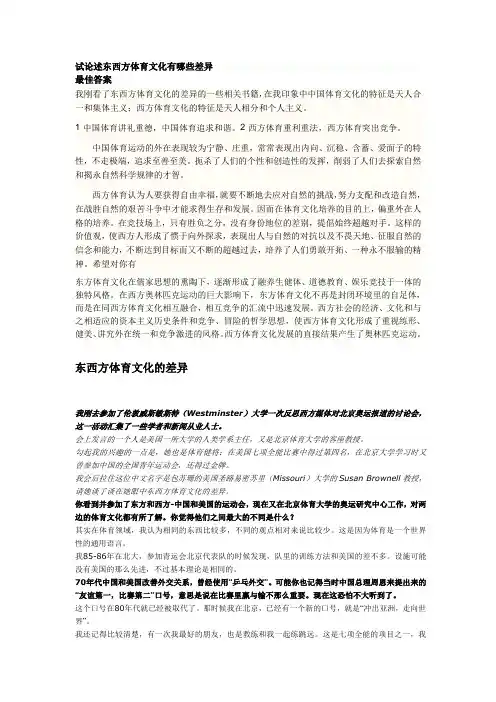
试论述东西方体育文化有哪些差异最佳答案我刚看了东西方体育文化的差异的一些相关书籍,在我印象中中国体育文化的特征是天人合一和集体主义;西方体育文化的特征是天人相分和个人主义。
1·中国体育讲礼重德,中国体育追求和谐。
2·西方体育重利重法,西方体育突出竞争。
中国体育运动的外在表现较为宁静、庄重,常常表现出内向、沉稳、含蓄、爱面子的特性,不走极端,追求至善至美。
扼杀了人们的个性和创造性的发挥,削弱了人们去探索自然和揭永自然科学规律的才智。
西方体育认为人要获得自由幸福,就要不断地去应对自然的挑战,努力支配和改造自然,在战胜自然的艰苦斗争中才能求得生存和发展。
因而在体育文化培养的目的上,偏重外在人格的培养。
在竞技场上,只有胜负之分,没有身份地位的差别,提倡始终超越对手。
这样的价值观,使西方人形成了惯于向外探求,表现出人与自然的对抗以及不畏天地、征服自然的信念和能力,不断达到目标而又不断的超越过去,培养了人们勇敢开拓、一种永不服输的精神。
希望对你有东方体育文化在儒家思想的熏陶下,逐渐形成了融养生健体、道德教育、娱乐竞技于一体的独特风格。
在西方奥林匹克运动的巨大影响下,东方体育文化不再是封闭环境里的自足体,而是在同西方体育文化相互融合,相互竞争的汇流中迅速发展。
西方社会的经济、文化和与之相适应的资本主义历史条件和竞争、冒险的哲学思想,使西方体育文化形成了重视练形、健美、讲究外在统一和竞争激进的风格。
西方体育文化发展的直接结果产生了奥林匹克运动。
东西方体育文化的差异我刚去参加了伦敦威斯敏斯特(Westminster)大学一次反思西方媒体对北京奥运报道的讨论会,这一活动汇集了一些学者和新闻从业人士。
会上发言的一个人是美国一所大学的人类学系主任,又是北京体育大学的客座教授。
勾起我的兴趣的一点是,她也是体育健将:在美国七项全能比赛中得过第四名,在北京大学学习时又曾参加中国的全国青年运动会,还得过金牌。
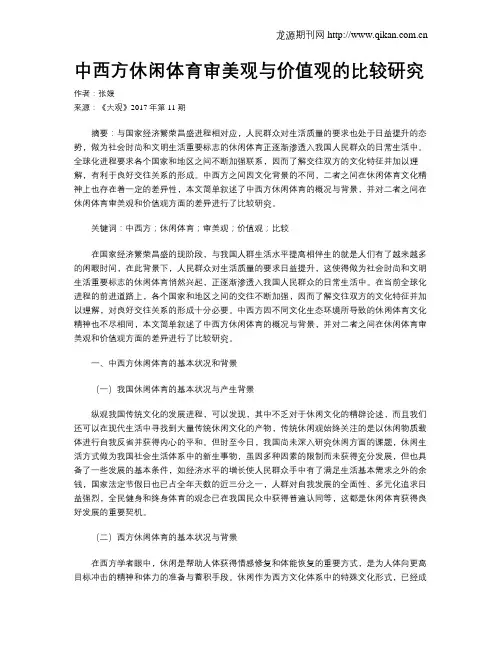
中西方休闲体育审美观与价值观的比较研究作者:张媛来源:《大观》2017年第11期摘要:与国家经济繁荣昌盛进程相对应,人民群众对生活质量的要求也处于日益提升的态势,做为社会时尚和文明生活重要标志的休闲体育正逐渐渗透入我国人民群众的日常生活中。
全球化进程要求各个国家和地区之间不断加强联系,因而了解交往双方的文化特征并加以理解,有利于良好交往关系的形成。
中西方之间因文化背景的不同,二者之间在休闲体育文化精神上也存在着一定的差异性,本文简单叙述了中西方休闲体育的概况与背景,并对二者之间在休闲体育审美观和价值观方面的差异进行了比较研究。
关键词:中西方;休闲体育;审美观;价值观;比较在国家经济繁荣昌盛的现阶段,与我国人群生活水平提高相伴生的就是人们有了越来越多的闲暇时间,在此背景下,人民群众对生活质量的要求日益提升,这使得做为社会时尚和文明生活重要标志的休闲体育悄然兴起,正逐渐渗透入我国人民群众的日常生活中。
在当前全球化进程的前进道路上,各个国家和地区之间的交往不断加强,因而了解交往双方的文化特征并加以理解,对良好交往关系的形成十分必要。
中西方因不同文化生态环境所导致的休闲体育文化精神也不尽相同,本文简单叙述了中西方休闲体育的概况与背景,并对二者之间在休闲体育审美观和价值观方面的差异进行了比较研究。
一、中西方休闲体育的基本状况和背景(一)我国休闲体育的基本状况与产生背景纵观我国传统文化的发展进程,可以发现,其中不乏对于休闲文化的精辟论述,而且我们还可以在现代生活中寻找到大量传统休闲文化的产物,传统休闲观始终关注的是以休闲物质载体进行自我反省并获得内心的平和。
但时至今日,我国尚未深入研究休闲方面的课题,休闲生活方式做为我国社会生活体系中的新生事物,虽因多种因素的限制而未获得充分发展,但也具备了一些发展的基本条件,如经济水平的增长使人民群众手中有了满足生活基本需求之外的余钱,国家法定节假日也已占全年天数的近三分之一,人群对自我发展的全面性、多元化追求日益强烈,全民健身和终身体育的观念已在我国民众中获得普遍认同等,这都是休闲体育获得良好发展的重要契机。
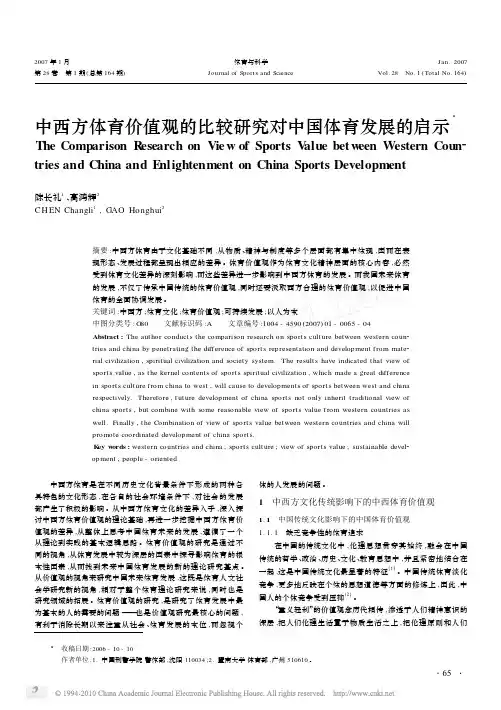
2007年1月体育与科学Jan.2007第28卷 第1期(总第164期) Journal of Sport s and Science Vol.28 No.1(Total No.164)中西方体育价值观的比较研究对中国体育发展的启示3 The Comparison R esearch on Vie w of Sports V alue bet w een Western Coun2 tries and China and E nlightenment on China Sports Development陈长礼1,高鸿辉2CH EN Changli1,GAO Honghui2摘要:中西方体育由于文化基础不同,从物质、精神与制度等多个层面都有集中体现,因而在表现形态、发展过程都呈现出相应的差异。
体育价值观作为体育文化精神层面的核心内容,必然受到体育文化差异的深刻影响,而这些差异进一步影响到中西方体育的发展。
而我国未来体育的发展,不仅了传承中国传统的体育价值观,同时还要汲取西方合理的体育价值观,以促进中国体育的全面协调发展。
关键词:中西方;体育文化;体育价值观;可持续发展;以人为本中图分类号:G80 文献标识码:A 文章编号:1004-4590(2007)01-0065-04Abstract:The author conducts the comparison research on sports culture between western coun2tries and china by penetrating the difference of sports representation and development f rom mate2rial civilization,spiritual civilization and society system.The results have indicated that view ofsports value,as the kernel contents of sports spiritual civilization,which made a great differencein sports culture f rom china to west,will cause to developments of sports between west and chinarespectively.Therefore,f uture development of china sports not only inherit traditional view ofchina sports,but combine with some reasonable view of sports value f rom western countries aswell.Finally,the Combination of view of sports value between western countries and china willpromote coordinated development of china sports.K ey w ords:western countries and china;sports culture;view of sports value;sustainable devel2opment;people-oriented 中西方体育是在不同历史文化背景条件下形成的两种各具特色的文化形态,在各自的社会环境条件下,对社会的发展都产生了积极的影响。
东西方体育文化的异同体育作为一种普及广泛的活动,在东西方都有着深厚的文化底蕴。
尽管在整体发展历程和细节方面存在一些差异,但东西方体育文化之间仍然有着一些共同之处。
本文将从体育发展历史、竞技精神、体育价值观以及体育传媒等方面探讨东西方体育文化的异同。
一、体育发展历史东方和西方的体育发展历史有着明显的差异。
在东方,古代的体育运动主要以武术为主,如中国的太极拳、剑术等。
这些活动强调优雅和内外的和谐,同时也是一种修身养性的方式。
而在西方,古希腊罗马时期的体育竞技对于西方体育文化有着重要的影响。
古希腊的奥运会是最早的国际体育赛事,同时也是西方体育竞技的起源。
二、竞技精神东西方体育文化都强调竞技精神,追求卓越和胜利。
然而,东方体育文化更加注重团队合作和和谐,注重集体荣誉。
中国的国家体育精神“团结拼搏,勇攀高峰”就体现了这种价值观。
而西方体育文化更加强调个人成就和竞争,强调个人的的努力和才华。
例如,美国的篮球巨星迈克尔·乔丹就是体育界的代表。
三、体育价值观东西方体育文化的价值观也有一些差异。
在东方,重要的体育价值观包括健康、和谐、文化传承等。
体育活动被视为一种提高身体素质和培养心理素质的方式,同时也是传承文化的一种途径。
而在西方,体育文化更加强调竞技、个人成就和商业化。
许多西方体育项目都以商业成功和娱乐为导向,例如美国的职业足球联赛NFL和职业篮球联赛NBA。
四、体育传媒东西方体育文化在体育传媒方面也有一些差异。
在东方,体育报道更加注重比赛结果和赛事报道,尤其是在国家级赛事上。
媒体对国家队的报道往往占据主导地位,体现了国家的凝聚力和团结精神。
而在西方,体育传媒更加注重个人运动员和明星,体育报道更加娱乐化。
媒体往往将运动员的个人生活和八卦报道作为焦点,强调明星的魅力和个人品牌。
综上所述,东西方体育文化在发展历史、竞技精神、体育价值观和体育传媒方面存在一些明显的差异。
尽管有差异,东西方体育文化仍然有着一些共同之处,例如都强调竞技精神和体育价值观的重要性。
中西体育文化有哪些方面不同
1、体育项目差异。
中方体育文化最直观、最鲜明的差异体现在体育项目选择的特点上。
中国的传统体育项目自古至今表现出的一个极大的特点就是注重表演、娱乐和养生,以竞技体育为辅,多采取各种活动形式。
防文化则具有浓厚的古希腊色彩,拜英雄,挑战极限,渴望胜利,注重竞技。
2、体育锻炼方式的差异本质上是中西方体育文化结构的差异。
中国体育文化主张身体锻炼以外达内,度重视心理状态的训练。
西方体育则突出人的身体形态,强调的是身体的外部运动,追求的是更快、更高、更强,宣扬对健美人体的崇拜和对力的赞美。
3、体育价值观差异。
中方文化的体育价值观念是迥然不同的。
方体育文化肯定体对于人和人生价值的同时鼓励通过身体性活动而
体现出来的对个性解放的追求和通过竞争来实现生命价值的创造,体现"更高、更快、更强’的价值目标。
在个体价值观的选择上,中国传统体育文化强调体育的“嬉戏”和养气、养生、养性、养志养气价值,崇尚身体修养和道德修养的和谐统一。
浅谈中国传统体育与西方体育文化理念的融合作者:汪皓来源:《新课程·教师》2009年第12期摘要:本文对中国传统体育与西方体育文化理念特征进行了详细地阐述,提出中国传统体育与西方体育文化既存在冲突,更应注重融合的观点。
关键词:传统体育西方体育体育文化中国民族传统体育文化是指由中国古代文明演化而成,在农业经济背景下,以中国传统哲学的身体观、生命观为思想基础,以独特的养生术、武术为主要外在表现形式的体育文化现象。
西方体育文化则是指由古希腊文明演化而成,在工业经济背景下,以西方近代科学的身体观、生命观为理论依据,以特殊的竞技运动为主要外在表现形式的体育文化现象。
一、中西方体育文化的内容与特征中国传统体育文化和西方体育文化在世界体育文化中同步发展起来,早期两种体育文化是沿着同一条有利于自身生存和发展的,单一取向的道路不断积累和发展的。
中国传统体育文化深受儒、释、道相互渗透影响,从其哲学基础和价值观念的核心层次到活动内容、运动形式等方面,与在西方哲学和价值观念基础上发展起来的西方近现代体育文化存在着巨大的差异,是两种不同性质的体育文化。
1.中国传统体育的心身共育与西方体育的更快更强用朴素的唯物主义哲学作指导是中国传统体育的根本特征,是中国传统体育的理论支柱。
我国古代的哲学家认为人的始基物质是“气”——“人之气,气之聚也,聚则生,散则为死”。
而这一条件取决于人体自身组织中“阴”“阳”结构的运动状态,阴阳和则寿,阴阳离则夭。
按照这一原则,人既需要保持一定量的运动,又必须防止过度剧烈的运动,既要通过“小劳”保持相对稳定的阴阳运动,而又要减少“元气”的亏损,从而达到长寿的目的。
中国传统体育表现出典型的整体性特征,始终将人的整体性作为健身、练习的出发点和归宿。
即把人与自然看作一个整体,强调“天人合一”。
这种整体的自然观与生命观在保健性、康复性体育活动中表现得尤为明显,在传统的气功、武术和养生活动中,随处可见整体生命观的影响。
浅谈中外大学生体育教育观念比较分析大学生体育教育是大学生高校教育的重要内容,随着高等教育的日益普及,大学生的数量与日俱增,学者们对于大学教育模式探讨的视角也不断扩大,教育的目的不再仅仅是了传播文化和锻炼体魄,更是为了塑造健康的心灵和健全的人格。
培养德、智、体全面发展,身体与心灵同步健康成长的大学生成为了当今时代背景下高校的重要任务。
因此,在我国教育与欧美日韩还存在差距的情况下,我们势必努力探知二者的异同,“师夷长技以制夷”,为改善国内大学生体育教育的现状做好铺垫。
一、常见体育观念分析目前,主流的体育观念主要包括快乐体育、健身体育、终身体育、人文体育等等。
第一,快乐体育。
快乐体育是指:从情感教学入手,为大学生进行以健全的身体教育和人格教育为目的的体育教育思想。
简而言之,就是寓教于乐,为终身体育奠定基础。
第二,健身体育。
健身体育,即体育最原始的含义:强健体魄。
第三,终身体育。
终身体育是终身教育的衍生品,最早由教育专家朗格朗提出。
它包括两方面的含义:一是指从生命开始到生命结束中学习和参加身体锻炼,使终身有明确的目的性,是体育成为一个人生活中始终不可缺少的重要内容;二是在终身体育思想的指导下,以体育的体系化、整体化为目标,为人在不同时期、不同生活领域中提供参加体育活动机会的实践过程。
第四,人文体育。
人文体育是指:大学体育在使学生体魄强健的同时也应使学生感受其中的人文情怀,在运动精神中领悟中华民族文化的魅力。
二、国内外教育观念对比(一)日本快乐体育和人文体育的观念日本的经济随着第二次世界大战的结束得到了高速发展,随之提高的不仅是日本的国民生活水平,更包含了国民素质,这些变化为大学的教育提出了更高的要求,包括大学体育教育。
改革后的日本教育为日本培养了大量适合各行各业的高素质人才,各类学富五车、具有武道精神、热爱锻炼的年轻人毕业进入社会。
多样化的改革教学适应了社会对多元化人才的需求,为日本社会输送了大量创造型人才。
浅析中西方体育文化的差异一.中西方体育文化在源流上的差异我们知道,任何事物的发展都有其历史的连续性,现存社会是历史上社会的延续.现存的文化也是历史上文化的发展,人类任何一个历史阶段的文明都是在原有文明基础上发展而来的。
体育的发展也是如此.也必然具有长期历史演进中所形成的民族风格和民族特色,它是体育文化的源头,体育文化的形成离不开历史传统的影响。
以美国为例,美国社会没有封建社会的历史,没有长期封建思想的影响及其所形成的传统习惯。
相反,它是由来自不同文化背景的移民组成。
由于交通较为发达,异族入侵和民族迁徙频繁,在其近二百多年的发展中,外受西方近代民主的熏陶,内受移民民族精神的影响,呈现出富于变动性和扩张性的多元文化杂交特征。
所以,在其不太长的历史中形成了较好的民族传统,这或许是它之所以形成今天这种价值观、民族精神和体育思想的历史渊源。
我国社会存在着长达数千年的高度封建专制统治,这种传统至今仍然深刻的影响着我们的社会。
在这种高度专制的社会结构中,君主决定一切,拥有统治天下的无限权利,臣民在君主面前只能绝对服从,而没有任何个人的民主权利。
在这几千年的封建统治的长期压制下,我国逐渐形成了一种与这一社会相适应的奴性文化,使得人们的创造活力、进取精神,严重受到了束缚。
从历史的发展来看,中国缺少民主制的历史,却有太多专制的影响,由于中国封建社会的核心始终围绕个人与集体的关系而转动,形成了重整体轻个体的价值观念,这使得中国传统体育活动的开展必须以“德、礼”等伦理道德标准为前提,这是一个不争的事实。
如果说民主传统产生出来的是个性、权利和自由这些特质的话,那么,专制文化遗留给今天的则是完全相反的东西,那就是不容置疑的权威和服从。
我们今天的体育中表现出来的集体精神、讲究整体和秩序,无不折射出历史留给我们的权威和服从的传统观念,其中的整体主义尤其压抑人们个性的发展。
这就是我们的体育为什么常常凸现这些东西的历史原因。
二.中西方体育文化在历史文化背景上的差异体育文化有着极其鲜明的历史阶段性.,中西方文化各个不同的阶段表现出的特性也形象的显示了两者的差异。
中西方体育文化论文-体育文化论文-文体论文——文章均为WORD文档,下载后可直接编辑使用亦可打印——一、中西方体育文化比较差异1.中西方体育文化哲学观的差异东方文化领域内的大多数民族注重在运动中修身养性,由此形成的体育文化往往将伦理道德视为重点,强调人文精神和人本思想,重文轻武,崇尚中庸之道。
其中,尤以中华民族的传统体育为典型代表,它在自给自足的自然经济基础上,发展出以宗法体制为背景,以儒、道思想为核心的文化精神。
中国古代的哲学家们提倡人与自然应该处于一种和谐统一的关系之中,因此提出“天人合一”、“身心合一”的哲学观,指的是人们在社会生活中力图达到身心兼修,阴阳平衡,个人内外的协调统一。
这种哲学观一旦与体育活动相结合,就形成了以提高个体内在修养和塑造个体人格为目的的体育文化精神。
由于中国传统体育文化精神的根本要求是通过锻炼身体以达到心灵的升华,因此可以说,中国传统体育是一种“以心为本”的体育。
既然古人从事体育活动主要是为了修身养性、益寿延年,那么就会倾向于选择直观领悟和内在意念修炼的方式而不是诉诸于求助外部力量,更不会通过人与人之间的身体对抗与较量来实现。
所以,中国传统体育活动方式表现出鲜明的“自娱性”特点,讲求的是个体通过身心双修,达到内在与外在、形与神的和谐统一,即在体育活动中,不仅要注重养身,而且还要自外而内地养性、养志、养气、养心,强调运动中的身体最终能够达到“精、气、神”浑然一体的境界。
即使是要进行体育竞技活动,古人也认为那些体能、速度、技巧等身体机能的较量太浮于表面,高手之间较量的应该是精神境界的高下,包括心智、人格、修养。
因此,在中国体育史上,鲜少发展出像西方体育那样竞争性强、对抗激烈的比赛项目,这与西方自古以来崇尚挑战和冒险,追求不断超越人类运动能力极限的体育理念是截然相反的,热爱竞争运动的西方人则在现代社会将这一体育理念明确表述为“更快、更高、更强”的奥林匹克精神。
西方传统文化是建立在个人主义的哲学精神基础之上的,其总体特征主要表现为肯定个人自由,支持平等竞争,鼓励个人不断超越自我,突破生理与心理的极限。
Contents摘要 (1)Abstract (4)1 Introduction (5)1.1 A Brief Introduction to Taiji (5)1.2 A Brief Introduction to Boxing (5)2 A Comparison Between T aiji and Boxing ·····错误!未定义书签。
2.1 Material Arts Cultures Reflected in Taiji and Boxing错误!未定义书签。
2.1.1 Thinking Skills··········································错误!未定义书签。
2.1.2 Training Methods······································错误!未定义书签。
2.2 Fitness V alue Between Taiji and Boxing (7)2.2.1 Focuses (7)2.2.2 Arbitrariness (7)3 Differences in Sports Value Between China And the West (7)3.1 Differences in Goals (7)3.2 Differences in fitness-building (9)4 The Main Causes of the Differences in Sports Value (10)4.1 Divergences in Historical Culture Background (10)4.2 Divergences in National Characters and Ways of Thinking (11)5 Conclusions and Implications (13)Bibliography (14)Acknowledgement (15)从中国太极和西方拳击的比较看中西方不同体育文化价值观摘要体育是一种以形体活动为表现形式的文化,有着丰厚的民族文化底蕴,在历史发展中逐渐成为一种民族文化象征。
笔者希望在文化渗透急剧发展的今天,以中国太极与西方拳击为依托浅析中西方不同体育价值观。
本论文主要采取对比分析及归纳总结的方法成文。
在比较了中国传统武术——太极和西方流行的拳击运动后,可知这两种运动各有优点。
首先,对太极和拳击理论原则上的研究,使得太极和拳击的差别显而易见,主要表现在武术文化和健身价值两方面;其次,通过客观地比较和分析,太极和拳击各自有利有弊;最后,通过总结,两者在对体育价值观的发展上都起着毋庸置疑的重要作用。
只有在认真收集材料、分析材料和对比总结的基础上,研究中西方体育价值观才会有新发展、新突破。
关键词:太极;拳击;体育价值观An Insight into Chinese and Western Sports Valueby Comparing T aiji and BoxingAbstractSport is a kind of physical activity as the manifestation of culture, it riches in national culture. In the long history, sport has gradually become a national cultural symbol. This paper sets out to examine the cultural infiltration of today's development of Chinese traditional Taiji and Western boxing. In view of the controversy between traditional Chinese material art ----Taiji and boxing,which is popular in western countries, individuals advance that each of them has its advantages. Firstly, utilizing the theory of the principal contradiction in them, we demonstrate that the main difference between traditional Taiji and modern boxing lies in their material art cultures and fitness values, based on which, each of them is defined. Secondly, by objectively comparing and analyzing, we point out that each of them has its advantages and defects. Thirdly, a conclusion is given that each of them should not be neglected in sports value's development. It was found that the data should be seriously collected, analyzed and examined, and sports valve development during the period studied can get qualitatively continuous with subsequent development on that basis.Key words:Taiji; Boxing; Sport valueAn Insight into Chinese and Western Sports Valueby Comparing T aiji and Boxing1IntroductionTaiji has become increasingly popular worldwide as a C hinese traditional material art which signal its emphasis on fitness-buiding and relaxation. However, boxing is the sport of fighting with fists, it originates in western countries and also gain its popularity among the individuals. This part shows the introductions of Taiji and Boxing relatively. It tells the origins and histories of the two, and many others.1.1 A Brief Introduction to T aijiTaiji (also written as T'ai Chi, Taiji, Tai Chi Chuan, among others) is a kind of slow movement, moving meditative exercise for relaxation, health and self-defense. Taiji is regarded as one of the internal styles of martial art in China, and it is the most widely accepted martial art world-wide today. The term refers to the ancient Chinese cosmological concept of the interplay, which is between two opposite yet complementary forces, like (Yin and Y ang) as being the foundation of creation. Taiji has its origins in Taoism and Martial Arts.Taiji Quan means “Supreme Ultimate Boxing”. Structurally speaking then, the Taiji Quan practitioners focus on neutralizing his competitors‟use of the degree of force before applyinga countering force of his own. In this give and take, the interplay of energies, Taiji finds itshighest expression. (Edson Lee, 2002, p.12) [6]1.2A Brief Introduction to BoxingBoxing is one of the oldest martial arts styles of the western countries. It is also known as fist pugilism, In other words, boxing is the sport of fighting with the fists. Basically, boxingis generally played by two players where they fight, knocks each other on proper techniques. There are various types of boxing, for example, bare-knuckles boxing. Y ou have to play the game without wearing any gloves at all. And there is also another type of boxing where you have to wear boxing gloves. (张枫. 2001. p.21)[4] However, boxer requires boxing equipments to protect him against damages and injuries from the opponent. Some of the boxing equipments include boxing gloves, headgear, punching bags, rings, and many others. However, these gears will be highly helpful to the players, because these equipments will protect them against damages when fighting against one another. The players have to fight a series of rounds (normally 12) with one-three minutes intervals. One wins if his opponent is knocked down and can‟t get up in ten counts, or in another way, if he is declared too injured to carry on.In a boxing match, there can be three judges. During the match, they maintain a score card depending on the perfection with which the boxers perform. The boxers are required to follow the instruction properly. However, a good performance is like this: one boxer has the correct punches that connect, and also knockdowns and defense. Violation of these rules is termed as "fouls". Fouls probably lead to disqualification of the offending boxer and thus lead to a default loss.2 A Comparison Between T aiji and BoxingBased on their big difference, here the article compares the two in two perceptions. one is the comparison of Material Arts Cultures Reflected in Taiji and Boxing, the other is that of Fitness V alue Between Taiji and Boxing.2.1 Material Arts Cultures Reflected in T aiji and BoxingFrom the aspects of the thinking skills and training methods of Taiji and Boxing respectively, the differences are not difficult to find.2.1.1 Thinking SkillsThis article insists that making people learn and practice the Chinese Taiji Martial Arts can not only make them actually master one or two body exercising skills which are prior to their contacting the practical job, but also have active and direct effects on the improving people‟s moral and ideological quality through accepting the idea of polish of people‟spersonality and body among the Chinese Taiji Martial Arts. The mode, in “Zhou Yi” (Book of Changes), of “like”thinking, is the original thinking skill of Chinese Taiji. It is great and profound whether it influences Chinese traditional culture in a positive or negative way. In this regard, it is the way of thinking that has determined the appearances, features and trends of Chinese Taiji, and has determined the view of sports values, the mode of behaving manner, the awareness of aesthetics, and folkways or customs that Chinese people have their own personalities. This kind of way of thinking naturally and definitely has infiltrated through the mode of human motion in China, influencing the development of Taiji. (刘淑君, 2004, p.11)[1] The power of positive thinking in boxing is unbelievable. Whether it is boxing, golf or any other sport, there are numerous numbers of techniques that help to relax the mind and muscles of every boxer. Breathing exercise by closing eyes, breathing through nose and out deeply through mouth is a good start. Boxing for success gained its status as a focusing aim in its status as a focusing aim in its thinking skill. The learning aims of boxing are: it can improve literacy, numeric and ICT skills, and improve motivation and encourage learning resilience.Boxing is a very unique sport. At its face value, the aim is to inflict blows on your competitors and avoid injury yourself by landing more punches than you receive. Therefore, a very common perception is that boxers need to psyche themselves up into a frenzied state, fuelled by anger with the intention of causing injury. But, for those who have worked in boxing, this perception could not be further from the truth.Boxers are convinced that their sport is a type of physical chess –a battle that is as much psychological and tactical as it is physical. However, it is not getting away from the brutality of the sport; other sportsmen and women may “play”matches, however, boxers …fight‟ them. In a sport where there is only one winner, seeing an opponent strugglingphysiologically during a competition provides a large source of motivation, and boxers look to exploit every weakness or frailty in their opponents.Many people hold the view that boxers need to be mentally tough to compete. While few boxers use sport psychologists, most recognize the importance of psychology to performance. “The legendary trainer Cus D‟Amato, who steered Floyd Patterson and Mike Tyson to world heavyweight titles, o nce said that …fights are won and lost in the head‟ and this bears testament to the importance of psychological factors for performance.” (David Green, 1989, p.221)[8] 2.1.2 Training MethodsTaiji is inherited as a great sport treasure of China, because Chinese government has paid great attention to it. As a popular substance in physical education and a good means of physical training, Taiji is very famous and has been spread throughout the whole China and many other western countries. The training method of show boxing is very important. According to the present situation, different teaching methods has been compared and much attention has been paid to the steps in training Taiji, so he has found out a set of unique way of studying Taiji for the common people. Developing training principles and methods on training of “Simple Taijiquan”is conformed to the principle of consolidated teaching as well as modern auto-controlled teaching. The experimental result reflects that, it could develop students‟psychological quality and be good for the consolidation of correct exercises, and improve memorizing exercise movement as well. During the training of “Simple Taijiquan”, the effect of using emotive training teaching is more effective than traditional training method.Boxing is one of the world-famous sports in the world. It involves attack and defense with the fists. However, boxing trainer plays a very important part in becoming somebody a good boxer. One needs to be patient. The information on training method o f boxing is very important. One of the most commonly used boxing techniques is straight left jab to the head.In this method of techniques for boxing, the chin and partially the mouth has to be covered with the left fist of the boxer. According to the onward movement of the left fist, the left hand is straightened and the left elbow rises. The chin must be covered by the left fist. However, another basic boxing techniques straight jab to a stomach contains keeping the body bent in a waist and knees, take a step with the front foot when the target is contacted, and the extended arm has to be parallel to the floor as well. This jab can coerce the opponent to lower the arms and open the head for the further attack. Right uppercut is another kind of defense boxing technique. This method is done by standing in a boxing stance as well as holding the back knee bent. In this technique, you should lower your right shoulder to bight the right to make a semi-crouch point. The fist must be placed sufficiently upwards near the chin to cover the head. The hips have to be turned forward, pushing the ball of the back foot and punching the right fist up towards the target. The right arm stays very close to the boxer‟s body and it turns up in a semicircle. The game of boxing is gaining more and more popularity all over the world of sports today. Basically, this game involves two boxers where they punch each other to knock out each other. Y oung people can easily involve in this game. However, before stepping into the world of boxing, people should be properly trained. Boxers need to learn the boxing methods to play this game successfully.3 Differences in Sports Value Between China and the WestComparing the sports value in China and the west, the differences exist in their goals and the way of fitness-building. Taiji is the pearl of ancient oriental culture, and it aims at keeping fit and cultivating temper accordingly. Taiji can be regarded as one of the first choices of life-long sport term to promote and spread. While boxing is a unique sport, with its goal to inflict blows on your competitors and avoid injury yourself by landing more punches than you receive.3.1 Differences in GoalsTaiji is a traditional system of movement in China and meanwhile also western countries, with the focus of prevention regarding heart cycle illness, joint problems and muscular diseases. Taiji was first created as martial art with its focus of self defense and health cultivation. Chinese Taiji Quan has formed and developed for nearly 3,000 years and Taiji is the pearl of ancient oriental culture for its important philosophical meaning and profound exercise effects that arouse the individuals of western countries highly attention. The article relates to modern civilization which brings serial social problems. On the basic achievements, conduct further seep to how to use Taiji Quan to exercise. Keeping fit and cultivating temper accordingly, Chinese Taiji Quan can be regarded as one of the first choices of life-long sport term to promote and spread.While in western countries, successful boxers must desensitize themselves to the effects of bearing injury and accept many risks each time when they compete. Boxing is a unique sport. The focus of boxing is to inflict blows on your competitors and avoid injury yourself by landing more punches than you receive. Thus, a common perception is that the boxers need to psyche themselves up into a frenzied state, fuelled by anger with the purpose of causing injury. (李士英, 2001, p.225)[2]3.2 Differences in Fitness-buildingTaiji was first created as a kind of martial art which aims at health cultivation. Each time when Taiji Quan is practiced, the practitioner gains the feeling of comfort. The whole set of movements show an obvious combination of the practitioner‟s body, energy and spirit. Taiji is a harmonious presentation of Yin and Y ang, such as “lightness and heaviness”, “softness and hardness”, as well as “left and right”, “internal and external”. Above all, the m ovement of Taiji Quan is widely open and graceful, like moving clouds and flowing water; relaxed andsoft as a butterfly fluttering airily and gracefully; like a poem and it is as beautiful as a picture. It is an dynamic art with strong internal power, and apparent external softness and gracefulness as well. (Klaus Moegling, 1968, p.167) [10]While in western countries, successful boxers must desensitize themselves to the effects of bearing injury and accept many risks each time when they compete. Boxing is a unique sport. The focus of boxing is to inflict blows on your competitors and avoid injury yourself by landing more punches than you receive. Thus, a common perception is that the boxers need to psyche themselves up into a frenzied state, fuelled by anger with the purpose of causing injury. Boxing is very suitable for the preventive movement work, but likewise for persons suffering from a damaged heart-cycle, so that boxing probably has become the subject of empirically created health studies. Certainly, empirical-analytically aligned research strategies cannot explain the health problems in connection with a movement system completely. In particular the subjectivity of the health phenomenon, the life-lay and various social influences and the associated non-standard variability make a generally accepted empirical investigation of the health effect of the boxing very difficult.4 The Main Causes of the Differences in Sports ValueTaiji is regarded as one of the popular styles of martial art in China, and it is the most widely accepted martial art throughout the world today. The comparison of the Chinese and Western sport value from the historical and cultural aspects reflected that during the different cultural processes. It is the way of thinking that has determined the differences of appearances, features and trends between Chinese Taiji and western boxing, and has determined the view of sports values, the mode of behaving manner, the awareness of aesthetics respectively.4.1 Divergences in Historical Culture BackgroundTaiji is term of Chinese traditional material art and it is a kind of slow movement, it is also a healthy exercise for relaxation and body-shape, health and self-defense. Taiji is regarded as one of the popular styles of martial art in China, and it is the most widely accepted martial art throughout the world today. Based on the historical culture value of Taiji, The comparison of the Chinese and Western sport value from the historical and cultural aspects reflected that during the different cultural processes, entertainments and sports can reflect the development of the Chinese and Western material arts, which are featured by perseverance and openness relatively. The Chinese material arts stress being healthy while the Western sports focus on success and failure. The term refers to the ancient Chinese traditional cosmological concept of the interplay, which is between two opposite yet complementary forces, like (Yin and Y ang) as being the foundation of creation. Taiji has its origins in Taoism and Martial Arts. Taiji Quan means “Supreme Ultimate Boxing”. Here refers to the Tao. Structurally speaking then, the Taiji Quan practitioners focus on neutralizing his competitors‟use of the degree of force before applying a countering force of his own. In this give and take, the interplay of energies, Taiji finds its highest expression. In this paper, how the Chinese traditional material art can meet the challenges brought by the outside world and how the world sports value will develop are expounded.At the end of 20th century, women‟s boxing was organized. However, during the 18th and early 19th centuries, fighting was an essential forerunner of boxing in Britain. For a generation following the Queensberry rules, bare-knuckle and glove-fights were both promoted and popular. The bare-knuckle fights were usually held under the “New Rules”produced by the Pugilistic Benevolent Society in 1866, which had superseded “the Pugilistic Association‟s Revised Rules”of 1853. Get more information on modern boxing so as tounderstand the activity of boxing. Boxing is one of the oldest martial arts styles of the western countries. It is also known as fist pugilism, In other words, boxing is the sport of fighting with the fists. Boxing is one of the oldest martial arts styles of the western hemisphere of this world. It is also known as fist pugilism or pugilism of the fist. In other words, boxing is the act or sport of fighting with the fists. Basically, the game of boxing is generally played by two players where they fight, knocks each other on proper techniques. The following article sharesa brief introduction to boxing.4.2 Divergences in National Characters and Ways of ThinkingThe Chinese Taiji martial arts can not only make them actually master one or two body exercising skills which are prior to their contacting the practical job, but also have active and direct effects on the improving people‟s moral and ideological quality through accepting the idea of polish of people‟s personality and body among the Chinese Taiji martial arts. It is great and profound whether it influences Chinese traditional culture in a positive or negative way. In this regard, it is the way of thinking that has determined the appearances, features and trends of Chinese Taiji, and has determined the view of sports values, the mode of behaving manner, the awareness of aesthetics, and folkways or customs that Chinese people have their own personalities. (Brown Lee, 1985, p.154)[9]This kind of way of thinking naturally and definitely has infiltrated through the mode of human motion in China, influencing the development of Taiji.The power of positive thinking in boxing is unbelievable. Whether it is boxing, golf or any other sport, there are numerous numbers of techniques that help to relax the mind and muscles of every boxer. Breathing exercise by closing eyes, breathing through nose and out deeply through mouth is a good start. Boxing for success gained its status as a focusing aim in its status as a focusing aim in its thinking skill. The learning aims of boxing are: It canimprove literacy, numeracy and ICT skills, and improve motivation and encourage learning resilience. (唐波, 2004, p.227)[3] Boxing is a very unique sport. At its face value, the aim is to inflict blows on your competitors and avoid injury yourself by landing more punches than you receive. Therefore, a very common perception is that boxers need to psyche themselves up into a frenzied state, fuelled by anger with the intention of causing injury. But, for those who have worked in boxing, this perception could not be further from the truth. The Chinese Taiji Martial Arts can not only make them actually master one or two body exercising skills which are prior to their contacting the practical job, but also have active and direct effects on the improving people‟s moral and ideological quality through accepting the idea of polish of people‟s personality and body among the Chinese Taiji Martial Arts. It is great and profound whether it influences Chinese traditional culture in a positive or negative way. In this regard, it is the way of thinking that has determined the appearances, features and trends of Chinese Taiji, and has determined the view of sports values, the mode of behaving manner, the awareness of aesthetics, and folkways or customs that Chinese people have their own personalities. This kind of way of thinking naturally and definitely has infiltrated through the mode of human motion in China, influencing the development of Taiji. The power of positive thinking in boxing is unbelievable. (Y Jianying, 2004, p.36) [11]5 Conclusions and ImplicationsTaiji Quan means “Supreme Ultimate Boxing”.Taiji is a kind of slow movement, moving meditative exercise for relaxation, health and self-defense. The Taiji Quan practitioners focus on neutralizing his competitors' use of the degree of force before applying a countering force of his own. Taiji determined the view of sports values, the mode of behaving manner, the awareness of aesthetics, and folkways or customs that Chinese people have their own personalities. (Allan Poe, 1995, p.163)[7] Developing training principles andmethods on training of “Simple Taiji Quan”is conformed to the principle of consolidated teaching as well as modern auto-controlled teaching.The power of positive thinking in boxing is unbelievable. Boxers are convinced that their sport is a type of physical chess. Boxing is a very unique sport. At its face value, the aim is to inflict blows on your competitors and avoid injury yourself by landing more punches than you receive.(赵刚, 2001, p.20)[5] Therefore, a very common perception is that boxers need to psyche themselves up into a frenzied state, fuelled by anger with the intention of causing injury. The power of positive thinking in boxing is unbelievable.Bibliography[1] 刘淑君.民族文化差异与武术国际化发展的哲学思考[J]. 上海:上海体育学院学报,2004,(2).[2] 李士英.武术散打[M].北京:北京体育大学出版社,2001.[3] 唐波.竞技武术与奥林匹克运动文化背景比较研究[J]. 北京:体育文化导刊,2004[4] 张枫.武术散打国际化现状及其对策研究[J]. 上海:武术科学出版社,2001,(3).[5] 赵刚.中国散打与美国综合格斗体育文化比较[M]. 上海:上海外语教育出版社,2001.[6] Brief Introduction Of Tai Chi. Edson Lee. June 2002. Y ork U. 16 Mar.2012</Chinese-martial-arts/Brief-Introduction-of-Tai-Chi.html>[7]Allan Poe, J. Foundations of Sport and Exercise Psychology. New Y ork Press, 1995[8] Boxing Techniques. David Green. March 1989. American Boxing Association. 22.Mar.2012 </western-martial-arts/Boxin-Techniques-Chi.html>[9] Brown Lee, J. Chinese Material Arts. Cambridge, Cambridge University Press, 1985[10] Klaus Moegling, ed. Scientific test results of the health effects of Taijiquan. Institute forKinematics and Movement Research Press, 1968[11] Y Jianying, J. Research on the Comparison Between Traditional Wushu and ModernCompetition Wushu. Journal of Tianjin Institute of Physical Education Press, 2004AcknowledgementI have gained lots of benefits from the enlightenment of my supervisor ----Bao Chunyan, whose inspiring insights, generous encouragements, and enthusiastic instructions have facilitated me much throughout my paper writing. Her penetrating and insightful comments provide me with inspiring source. She has been in constant concern about my paper, spared no pains to help me complete my paper draft. I would also like to extend my sincere thanks to the English Department of City College of Wuhan University of Science and Technology as well as all my teachers. Thanks to their instructive guidance and comprehensive education during the four yea rs‟ schooling, I can acquire the opportunity to study English. Finally, my great gratitude also goes to those writers and editors whose works I have perused and benefited greatly from, and without their work, the completion of the paper would not have been possible.。